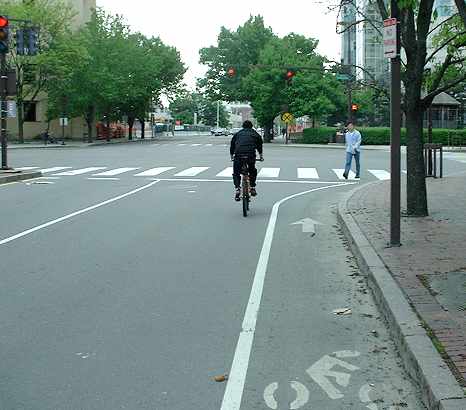 |
| Is this bike lane preferable? This cyclist doesn't seem to think so. |
| Is this wide outside lane preferable? |
 |
| Why not this standard width lane? |
Many times, I see discussions online about lane width. We are told that cyclists need bike lanes, or that, in the absence of bike lanes, cyclists need wide outside lanes so that we can operate safely alongside motorized traffic. Personally, I think these ideas are both based in misconceptions about what bicycles are and how they work. Both are based in the false notion that cyclists need only a small amount of space on the road, and that bicycles are somehow fundamentally different from other vehicles and ought to be kept out of the way. But in practice, narrow bike lanes tend to confuse motorists and increase conflicts at intersections. Conversely, wide outside lanes prevent cyclists from exerting the control over the lane that they may find necessary. The fact is, there is a precise width of lane that must exist for cyclists to operate their vehicles safely, and it's not the 4ft standard width bike lane, nor is it the 6ft standard width bike path, nor is it the 14ft wide outside lane. The proper width for a bike lane is the same as that of a standard or minimal width traffic lane - between 10ft and 12ft. Let me explain why.
In terms of bike lanes, they were originally designed for the convenience of motorists and they are almost always implemented in ways that were influenced more by what could be squeezed into the existing road width than by what cyclists actually need. Let's face it - bike lanes are as narrow as their designers can get away with. If transportation engineers figured that they could get away with making bike paths 2ft wide, they would do just that - and in some cases, they do. The US is better than Europe in this regard, and the standards here are (mostly) followed, but the fact is, that standard width of 4ft is not wide enough, nor is 6ft, which is the standard width for bike paths, a width that some cyclist advocates are requesting be made standard for bike lanes too. Even 8ft is too little. Such narrow lanes are ill-suited for use by bicycles, because bicycles, being two-wheeled vehicles with an inherent lack of stability and and proneness to wobble (especially at low speeds), need a lot more lateral room than their appearance would suggest. In my opinion, this is a big reason why cyclists on narrow bicycle facilities have so many collisions with static objects. It is also a big reason why bike lanes tend to increase intersection conflicts and why so many cyclists are killed by turning motorists at junctions or as a result of doorings mid-block. Cyclists (and indeed motorists) need a bike lane to be between 10ft and 12ft wide. 10-12ft allows motorists to fully merge before a right turn, and it allows cyclists to operate outside the door zone mid-block and with no fear of their vehicle's inherent instability putting them in conflict with other road users. 4ft is nowhere near enough, nor is 6ft.
As for wide outside lanes (14ft or more) vs. standard outside lanes (12ft), I prefer a standard width lane over a wide lane. The standard 12ft wide lane evolved to be the way it is for a number of reasons, and the design of both the bicycle and the car was influenced by this. The design elements that made up the bicycle, the car and the standard width lanes they travel on did not evolve in a vacuum, and although the full rationale behind these design elements is little-considered these days, there are good reasons for the standard width lane that go well beyond what is necessary for automobile traffic. Wider outside lanes would be good if many of us were driving tanks on the road - but they are not good for other vehicles, because lane control is essential if 'right of way' is to have any meaning, especially where cyclists are concerned. And unless we want chaos on the roads, right of way must have not just meaning, nor just force of law, but it must be supported by road design too. 12ft is good, because it allows cyclists to control the lane when necessary, preventing compact cars and larger vehicles from overtaking in the same lane. 14ft or more is not good, because of two reasons: 1 - in many states, lane control is illegal for cyclists on a 14ft lane (because cyclists are required to operate far-to-the-right in such a lane), and 2 - even where it is legal, when a cyclist finds it necessary to control the lane, the wide lane encourages motorists to squeeze past in the same lane as a cyclist, potentially on either side, at a time when such a maneuver could be extremely dangerous.
The best lane width for bikes is between 10ft and 12ft - no more, no less. That was the case in the 1890s and it's still the case today. It will continue to be the case as long as the bicycle is around, even after the last car disappears from the road. Bicycles are designed for relatively wide lanes (not too wide so that lane control becomes a problem, not too narrow so that bicycle control becomes a problem) - this is something that transportation engineers consistently fail to understand, because they are often not well versed in the mechanical and physical properties of the bicycle, so they do not understand how bikes move on the road or why their operation requires more than a narrow strip of asphalt.


